Disruption of the Bcl6 gene results in an impaired germinal center formation
- PMID: 9236196
- PMCID: PMC2199007
- DOI: 10.1084/jem.186.3.439
Disruption of the Bcl6 gene results in an impaired germinal center formation
Abstract
The Bcl6 gene has been identified from the chromosomal translocation breakpoint in B cell lymphomas, and its products are expressed highly in germinal center (GC) B cells. To investigate the function of Bcl6 in lymphocytes, we have generated RAG1-deficient mice reconstituted with bone marrow cells from Bcl6-deficient mice (Bcl6(-/-)RM). Lymphogenesis in primary lymphoid tissues of Bcl6(-/-)RM is normal, and Bcl6(-/-)RM produced control levels of primary IgG1 antibodies specific to T cell-dependent antigens. However, GCs were not found in these mice. This defect was mainly due to the abnormalities of B cells. Therefore, Bcl6 is essential for the differentiation of GC B cells.
Figures

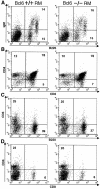
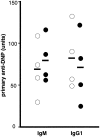


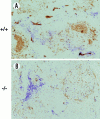
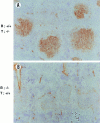
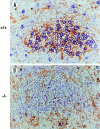
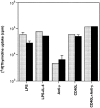
Similar articles
-
Differential regulation of germinal center genes, BCL6 and SWAP-70, during the course of MAIDS.Mol Immunol. 1999 Oct-Nov;36(15-16):1043-53. doi: 10.1016/s0161-5890(99)00121-2. Mol Immunol. 1999. PMID: 10698307
-
Deregulated BCL6 expression recapitulates the pathogenesis of human diffuse large B cell lymphomas in mice.Cancer Cell. 2005 May;7(5):445-55. doi: 10.1016/j.ccr.2005.03.037. Cancer Cell. 2005. PMID: 15894265
-
Smc3 dosage regulates B cell transit through germinal centers and restricts their malignant transformation.Nat Immunol. 2021 Feb;22(2):240-253. doi: 10.1038/s41590-020-00827-8. Epub 2021 Jan 11. Nat Immunol. 2021. PMID: 33432228 Free PMC article.
-
Do germinal centers have a role in the generation of lymphomas?Curr Top Microbiol Immunol. 1999;246:53-60; discussion 61-2. doi: 10.1007/978-3-642-60162-0_7. Curr Top Microbiol Immunol. 1999. PMID: 10396039 Review. No abstract available.
-
Mechanisms of action of BCL6 during germinal center B cell development.Sci China Life Sci. 2015 Dec;58(12):1226-32. doi: 10.1007/s11427-015-4919-z. Epub 2015 Nov 14. Sci China Life Sci. 2015. PMID: 26566802 Review.
Cited by
-
Evolution of two prototypic T cell lineages.Cell Immunol. 2015 Jul;296(1):87-94. doi: 10.1016/j.cellimm.2015.04.007. Epub 2015 May 1. Cell Immunol. 2015. PMID: 25958271 Free PMC article.
-
The long winding road toward understanding the molecular mechanisms for B-cell suppression by 2,3,7,8-tetrachlorodibenzo-p-dioxin.Toxicol Sci. 2011 Mar;120 Suppl 1(Suppl 1):S171-91. doi: 10.1093/toxsci/kfq324. Epub 2010 Oct 15. Toxicol Sci. 2011. PMID: 20952503 Free PMC article. Review.
-
Normal induction but attenuated progression of germinal center responses in BAFF and BAFF-R signaling-deficient mice.J Exp Med. 2003 Oct 20;198(8):1157-69. doi: 10.1084/jem.20030495. Epub 2003 Oct 13. J Exp Med. 2003. PMID: 14557413 Free PMC article.
-
TRAF3-EWSR1 signaling axis acts as a checkpoint on germinal center responses.J Exp Med. 2023 Aug 7;220(8):e20221483. doi: 10.1084/jem.20221483. Epub 2023 Apr 25. J Exp Med. 2023. PMID: 37097293 Free PMC article.
-
Compartmentalized multicellular crosstalk in lymph nodes coordinates the generation of potent cellular and humoral immune responses.Eur J Immunol. 2021 Dec;51(12):3146-3160. doi: 10.1002/eji.202048977. Epub 2021 Oct 20. Eur J Immunol. 2021. PMID: 34606627 Free PMC article. Review.
References
-
- Kerchaert JP, Deweindt C, Tilly H, Quief S, Lecocq G, Bastard C. LAZ3, a novel zinc-finger encoding gene, is disrupted by recurring chromosome 3q27 translocations in human lymphomas. Nature Genet. 1993;5:66–70. - PubMed
-
- Ye BH, Lista F, Lo DM, Coco, Knoeles R, Offit K, Chaganti R SK, Dalla-Favera R. Alterations of a zinc finger–encoding gene, BCL-6, in diffuse large-cell lymphoma. Science (Wash DC) 1993;262:747–750. - PubMed
-
- Miki T, Kawamata N, Hirosawa S, Aoki N. Gene involved in the 3q27 translocation associated with B-cell lymphoma, BCL5, encodes a Krüppel-like zinc-finger protein. Blood. 1994;83:26–32. - PubMed
-
- Bastard C, Deweindt C, Kerchaert JP, Leormand B, Rossi A, Pezzela F, Fruchart C, Duval C, Monconduit M, Tilly H. LAZ3rearrangements in non-Hodgkin's lymphoma: correlation with histology, immunophenotype, karyotype, and clinical outcome. Blood. 1994;83:2423–2427. - PubMed
-
- Lo Coco, F., B.H. Ye, F. Lista., P. Corradini, K. Offit, R. Knoeles, R.S.K. Chaganti, and R. Dalla-Favera. Rearrangements of the BCL6gene in diffuse large cell non-Hodgkin's lymphoma. Blood. 1994;83:1757–1759. - PubMed
Publication types
MeSH terms
Substances
LinkOut - more resources
Full Text Sources
Other Literature Sources
Molecular Biology Databases
Miscellaneous

